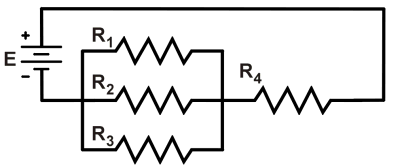Calculating Current in Series-Parallel Circuits
 Figure 1. Series-parallel resistors. |
In a circuit with resistors connected in both series and parallel, consider the circuit as a combination of parallel parts and series parts.
Use resistance formulas to determine the total resistances of the series and parallel parts. Then, use Ohm's Law to calculate the voltage drops across and currents through each part.
In the circuit of Figure 1, first use the parallel resistance formula to find the equivalent resistance R123.

Then the series resistance formula tells us RTOT = R123 + R4. So, Ohm's Law gives the total circuit current:

ITOT equals both the current I4 though R4 and the current I123 entering/exiting the parallel part. Using Ohm's Law:

So, knowing the value of V123, again apply Ohm's Law to find the current I1 through the parallel resistor R1:

and similarly for I2 and I3.
An Example
Given the circuit in Figure 1, suppose E = 9 V, R1 = 500 Ω, R2 = 1.0 kΩ, R3 = 1.5 kΩ, and R4 = 220 Ω. Then R123 = 273 Ω and RTOT = 493 Ω, so

and thus

And similarly for I2 and I3.
Note: It is important to carefully handle units with metric prefixes. Above, we adjusted the decimal point and units so that our formula for current yielded volts/ohms = amperes.
